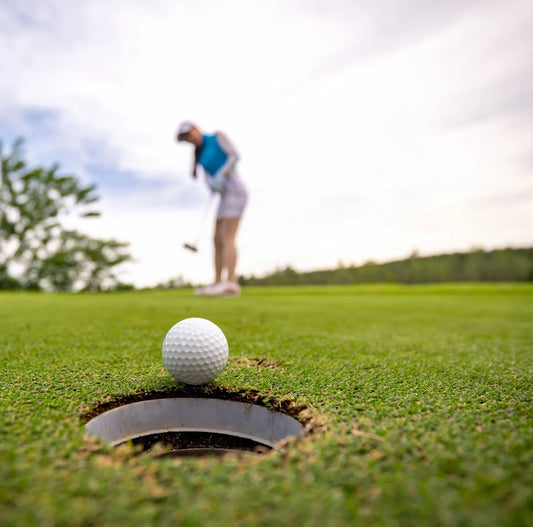Starting any new sport can be overwhelming, especially as an adult! Trying to learn golf can be especially complicated with the sheer amount of information and contradictory opinions available. When you’re learning golf for the first time, everything from the physical movement to the effects of confidence can offer challenges. There is a seemingly endless selection of articles, videos, and experts out there claiming to have the best advice for beginners, but all have seemingly different suggestions.
Additionally, there is particular stress in being a “newbie” in an otherwise male-dominated sport, especially one filled with complicated rules and unspoken etiquette. It is common for women to feel rushed, intimidated, or uncomfortable in a predominantly male environment they aren’t familiar with.
We’ve compiled a list of frequent questions beginner golfers have with detailed answers to help you feel confident when stepping up to the tee. Of course, these tips also hold value for beginner male golfers as well! Let’s dig into seven most common concerns and insider tips that will set all new golfers up for success.
At a Glance:
- Golf clubs: How many you need to use and what the numbers on each club mean.
- Dress for success: What to wear to keep you comfy throughout a game or practice session.
- Golf lessons: Taking lessons from a professional can help you learn correct technique and build your skill.
- When to play: Discover the best time of day for beginners to visit the golf course.
- Golf etiquette: Keep these unspoken rules in mind as you take to the green.
- Consistency: Level up your game with consistent practice, even if it’s on a small scale.
1. How Many Clubs Should I Use?
While the rules allow the use of up to 14 clubs during a stipulated round, beginners won’t need all 14 clubs right away. Instead, individual, pre-used golf clubs can be purchased online or at used sporting goods stores and are a great way to keep costs low while figuring out whether the sport is for you.
Most women should be playing with women’s clubs, which typically aren’t as heavy as men’s clubs. A full set of clubs can be very expensive so, before deciding if golf is for you, have a store associate or knowledgeable golfing friend help you pick out the best putter, driver, fairway wood, 7-iron, and wedge, especially if you’re buying them brand-new.
Once you’ve played golf for a while and know that you’ll continue playing frequently, ask a professional to fit you for a full matching set of clubs.
2. What Do the Numbers on Golf Clubs Mean?
The numbers on golf clubs indicate the degree of the golf club’s face and how far the club will hit the ball. The higher the number, the higher the ball is likely to go when hit by the club.
For starters, there are three parts to each club: the grip, the shaft, and the club head.
Woods, or the driver, are designed with the least amount of loft and have heavy, large clubheads. These help the balls fly the farthest. For beginners, it’s recommended to start with a driver of 11 or 12 degrees. These numbers will help you get the ball in the air as you work on mastering the basics of the game.
The other woods are called fairway woods and hybrids. These clubs, along with the driver, typically have longer shafts than the irons do. In a full set of beginner clubs, there are 9, 8, 7, and 6 irons, plus a combination of woods and hybrids beyond that. In a professional’s set, the irons will also go up to a 5, 4, and sometimes even a 3 or 2 iron.
Remember that the lower the number, the further the ball is designed to go. The higher the number, the higher in the air the ball is designed to go. For example, a 4-iron will go much further than a 9-iron, but the 9-iron will fly much higher in the air. Similarly, a 3-wood will go further than a 5- or 7-wood.
It will take several practice sessions, some instruction, and either a rangefinder or a tracking system to be able to determine how far each of your clubs will go.
When starting out at the range, it’s a good idea to use a tee at a low height every time it’s your turn to hit. With time, you may slowly graduate to hitting the ball off the ground as you get the hang of your natural golf swing.
3. What Are a Beginner’s Essentials?
When it comes to equipment, try not to be overwhelmed with the sheer number and cost of various accessories. Here are the core essentials to worry about:
Bag
You need something to put your clubs in! The traditional golf bag will hold 14 clubs and have side pockets for things like rain gear or a cover to keep the clubs dry.
Balls
Don’t worry about buying the expensive balls until you’re comfortable with the game. You should be able to purchase a box of basic golf balls for under $25. We recommend storing at least 10 balls in your golf bag so you’re prepared in case a few fly out of bounds!
Tees
A bag of 150 tees or more will last you a while! It is recommended to tee up each ball on the driving range until you are consistently making contact.
Glove
A glove is essential if you want to reduce the amount of blisters you get as a beginner. Gloves can also provide a better grip on the club, especially if your hands get sweaty over the course of the game. The best way to find the right glove is to visit a golf shop to find your size before purchasing any online.
Shoes
Purchasing a pair of spiked golf shoes can wait until you decide if golf is for you, especially since they can be expensive. Instead, many people play in athletic tennis or walking shoes.
Towel
It’s important to keep your clubs clean during a practice session or round of golf. To clean them, dip a towel in some water, wring it out, and wipe it over the face of your woods and irons after each hit. There are also brushes made specifically for cleaning out the grooves of the clubface!
4. What’s the Dress Code for a Golf Course?
There are many choices for women to choose from when deciding what to wear for a round of golf. Depending on the golf facility that you choose, there are different dress code rules.
Private facilities, like country clubs, often have a stricter dress code than municipal courses. This may require longer length skorts or shorts and a collared shirt for women. Pants, capris, and golf dresses are also acceptable.
Brands like Nike, Adidas, and Lululemon have golf clothing collections that are designed to keep you comfortable and prepared for different weather conditions. Stores like Dick’s Sporting Goods and Golf Galaxy also have clothing, clubs, and accessories available for purchase.
5. Should I Take Lessons from a PGA or LPGA Professional Right Away?
Although pricey, lessons and clinics from an LPGA Professional are a great idea if you want to know where to begin with your game. Small group clinics can also be helpful since they offer the opportunity for hands-on instruction in a fun, low-stress atmosphere with other beginners.
As your game progresses, individual on-course lessons are a wonderful option. Even though friends, partners, and strangers on the driving range can have the best intentions to be helpful, many give incorrect information. What works for one person may not work for someone else.
Trained professionals are able to see the cause and effect as well as the long-term repercussions of a swing or set-up change and tailor lessons to the individual.
6. What Is the Best Time of Day for Beginners to Get on the Golf Course?
Typically, weekend mornings and early afternoons tee sheets are packed with more experienced golfers that move at a faster pace. For beginners, this can be intimidating and uncomfortable.
After 3:00 PM is a good time to get out to play 3, 6, or 9 holes. If there is a group of golfers behind you waiting, you are allowed and encouraged to stand to the side and wave them through.
Depending on the size of the practice facility, the afternoon is also a good time to hit golf balls on the driving range or practice chipping and putting.
Par 3 courses are always a great option as well! The holes are shorter distances, so a driver is usually not necessary at these courses. As a beginner, don’t worry about scoring right away. Swinging in balance, making contact with the ball, and having fun should be your main goal.
7. What Are the Basic Rules of Golf Etiquette?
Golf is a sport filled with unspoken rules. Keep these seven rules in mind the next time you step on the green:
- Start on time: Get to the golf course with some time to spare before your tee time. You would rather be early than late to your tee time, and being early gives you time to stretch, warm up, hit some practice putts and chips, and grab a snack or beverage without delaying anyone after you.
- Mark your ball: Put a unique marking on your golf ball with a permanent marker. There is a penalty in golf if you hit the wrong ball, whether it’s an accident or not.
- Keep pace: Keep up the pace of play with the group in front of you. Walking at a brisk pace to get to your next shot, having multiple clubs with you (if you are riding in a cart), and knowing where the next tee box is located are all helpful to moving along at an acceptable pace. Most courses will expect you to finish a round of 18 holes in 4 hours and 15 minutes or less.
- Show respect: Repair your divots and any ball marks you make on the green.
- Drive safely: If you are driving a golf cart, obey cart rules. If a hole is really wet or under construction, oftentimes there will be a “cart path only this hole” sign, meaning you are not allowed to drive out into the fairway or rough.
- Notice putting lines:When you are on the putting green, do not walk across your own or a partner’s putting line (the line between where a ball rests and the hole).
- Be aware of where you are: Watch your location in relation to your playing partners. You do not want to be standing to the side or in front of anyone else as they are hitting as you might get hit! You also want to make sure you aren’t talking or making noise or movement as anyone else is hitting their golf ball as well.
Final Thoughts
Answering a few of these beginner’s questions should give you some confidence to kickstart your golf journey. With more and more women joining the sport, know that you’re not alone in feeling like a newbie. It may seem intimidating and expensive at first, but there are many options that make golf more affordable and approachable.
Golf can be played for a lifetime. As a beginner, embrace the process of improvement and remember that continual practice goes a long way. If you’re serious about improving your skills on the golf course, start with working on your short game with the PrimePutt indoor putting mat that’s great for all skill-levels and helps you prepare for the real experience on the green.





